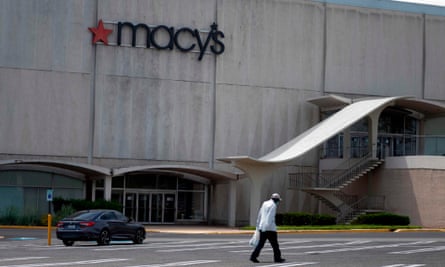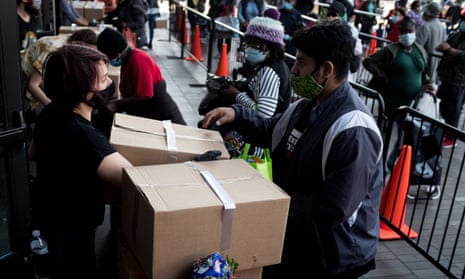Covid-19’s devastating assault on the US economy waned in May as the unemployment rate dipped to 13.3% and the US regained 2.5m jobs.
The surprise news follows the loss of 20m jobs in April, when unemployment hit 14.7%. Economists had been expecting a rise to as high as 20%. Stock markets in the US and Europe rose sharply on the news as investors bet on a quick recovery.
President Donald Trump celebrated the news at a press conference claiming it was proof the US economy was on the road to recovery. “This is better than a V,” Trump said of the shape of the country’s recovery curve. “This is a rocket ship.”
The unemployment rate remains still historically high, up from just 3.5% in February. A decade’s worth of gains made in the labor market since the last recession have been erased in just three months.
All 50 states have now begun easing quarantine restrictions, and the pace of this unprecedented hollowing has now slowed as some have returned to work – but uncertainties remain. Some 1.2m jobs were gained in leisure and hospitality over the month after huge losses in March and April.
Weekly unemployment claims have plummeted from a frightening peak of 6.6m in April to 1.9m last week but Jason Reed, a professor of finance at the University of Notre Dame’s Mendoza College of Business, said the numbers were still huge.
He worries America is now witnessing a shift from temporary to permanent layoffs.
The US pandemic initially hit the leisure and hospitality industry hardest, now the damage is spreading further, states are running out of cash and companies are burning through their stimulus checks.
Really Big Jobs Report. Great going President Trump (kidding but true)!
— Donald J. Trump (@realDonaldTrump) June 5, 2020
“The longer this goes on, the bigger the chance of permanent consequences,” said Reed. Without further help from Washington he predicted local governments and businesses would have to make some “very uncomfortable decisions”.
The headline figures do not show the full picture. A broader measure of unemployment which counts workers who have given up looking for a job and part-time workers who are seeking full-time employment paints an even bleaker picture of the situation. The measure – known as U6 – was 7% in February before the pandemic hit the US. Last month it was 21.2%.

Maria Elvira Gonzalez has worked for McDonald’s in Chicago for 19 years. She had been working 32 hours every two weeks before the pandemic, but lost all her hours at the restaurant in March. The restaurant is now open again for limited service, but Gonzalez has yet to be given any indication when she will get any work.
She said she was unsure whether she could claim unemployment benefits, and was relying on her daughter and local charities. “It has been very difficult to make ends meet,” she said. “Bills are unpaid. I feel humiliated and ignored.”
Gonzalez, 58, believes she has been passed over for younger workers, and sees few opportunities for herself in the current job market. “So many places are closed and thousands and thousands are unemployed,” she said. She said her economic situation was “the worst I have ever faced”.
William Rodgers, the former chief economist at the US Department of Labor, has been watching the jobs report for 20 years. “The sheer volume, size and rapidity of losses is something I have never seen before,” he said. He pointed out it took the US 16 months to reach a peak of 10% unemployment in the last recession.
Rodgers is hopeful the job market can start recovering in the months ahead, but said he worries a lack of political action could lead to deeper losses. Much of the $1.6tn in federal aid signed off by Congress to staunch the wounds to the economy from Covid-19 has already been spent, according to a Wall Street Journal analysis of government data and estimates by the Committee for a Responsible Federal Budget, a bipartisan nonprofit group.
Rodgers is also concerned about further business closures following possible fresh outbreaks of coronavirus as states reopen and protests over the police killing of George Floyd sweep across the US.
Rodgers, a professor of public policy at Rutgers University, said his research shows the most significant statistical factor in which states have reopened fastest so far has been political rather than epidemiological. He has more sympathy with the protesters. “It’s another do-or-die choice. If you don’t protest, you get more of what happened to Mr Floyd,” he said.
Another $3tn aid package proposed by Democrats is now being discussed in Congress but is meeting opposition from Republican senators.
With no immediate sign of a vaccine, the length of the coronavirus recession and the rise in unemployment is hard to fathom. The Congressional Budget Office recently estimated its impact could take a decade to unwind.
In Florida, Jeanie Bailey is hoping it is sooner. Bailey filed for unemployment benefits in March after Glory Tours, her Tampa-based travel business was wiped out by the pandemic. Florida’s unemployment system all but collapsed under the volume of applications and underfunding at the state level. It took 10 weeks for her to receive her first payment.
“It was a total nightmare,” said Bailey, who relied on family and savings to get by. Bailey, 50, sees no short-term solution to unemployment issues in tourist-dependent Florida.
Many of her clients are elderly and she said few were currently in the holiday mood. “Personally I too feel a little leery about going out and doing too much,” she said. “Realistically it’s going to take six months, maybe a year, to get back to normal.”
